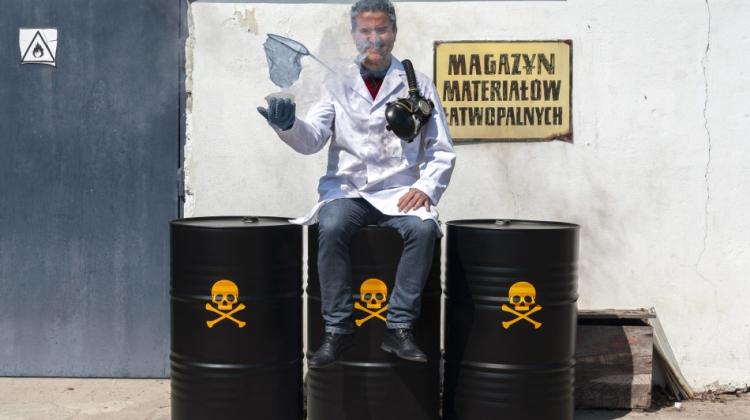The University of Silesia balloon will help in studies of air pollution

Scientists and students of the University of Silesia will use a hot air balloon to study the atmospheric pollution. It will be the first mobile laboratory of this type, offering the possibility of sampling that would be impossible with conventional methods.
The aim of the project is to create a unique, Poland\'s first such system of laboratories, an important element of which will be an airborne mobile laboratory equipped with diverse - depending on the needs of the project - measuring equipment placed in the basket of the balloon.
The core of the project will be stationary laboratories with equipment to study air pollution, which will be part of the University Atmospheric Control Laboratories - in short ULKA (Uniwersyteckie Laboratoria Kontroli Atmosfery), hence the name of the entire project; this name will probably be given to already finished balloon with a capacity of 3.5 thousand cubic meters, which is at the stage of commissioning.
The balloon will allow to carry out direct measurements of the gas components and aerosols, and collect air samples, in both horizontal and vertical gradient (gradient is the ratio of increase in value to increase in the distance - PAP) to an altitude of approx. 4 km.
Since the balloon has no power, its horizontal movement is consistent with the natural movement of air, creating a unique situation of sampling in the zones of the atmosphere which have not been disturbed by any mechanical device.
Maintaining a constant altitude of the balloon when in horizontal flight will allow to carry out measurements and sampling at constant altitude relative to the Earth from the pollution source such as a smokestack emitting pollution to the place where these impurities fall below the determination threshold.
This is possible because the balloon moves passively in the direction of dispersion of pollutants; this enables measurements related to the transport of these pollutants and determining their composition depending on the distance from the source.
The initiators of the project are scientists from various units of the University of Silesia in Katowice: Faculty of Earth Sciences, the Institute of Physics and the Faculty of Biology and Environmental Protection. Some of them, in addition to many years of experience in the study of the atmosphere, also have the appropriate permissions in the field of ballooning. The balloon will be useful, among others, for students of the new field of study: Environmental Hazards Engineering, students of the interdepartmental Environmental Protection course, as well as students of geophysics, geology, geography and biophysics.
The project received 300 thousand zlotys funding from the Regional Fund for Environmental Protection and Water Management in Katowice. This will be reflected by the colours of the balloon envelope. Dark blue is the colour of the University of Silesia, light green - the colour of the Fund, and the red part will contain the logos of the University of Silesia and the Fund.
According to the spokesman of the University of Silesia Jacek Szymik-Kozaczko, the balloon has been made by a company from the UK, selected in the tender. "Currently, the balloon goes through the commissioning stages, required for each aircraft. It must be certified and registered. These procedures are very detailed, meticulous and time-consuming, so they may take a while" - said the spokesman, expressing hope that the first public presentation of the balloon will be possible in the beginning of next year.
Representatives of universities emphasize that the project, of which ULKA is part, expands the educational offer of the university with an unconventional, yet very modern method of education in the field of monitoring the state of the environment, especially the atmosphere.
"Mobile laboratory placed on a balloon will allow students to learn modern research methods, applicable in the study of the environment, early detection of threats and their effective elimination" - noted Szymik-Kozaczko. He announced that in the future the lab will be equipped with an SUV, which will be used to transport the balloon and itself will be a laboratory with suitable research equipment, co-operating in real time with the devices on board the balloon.
On the other hand, retrofitting existing stationary laboratories of the University of Silesia with new equipment to test air pollution will help students and doctoral students master the methods and techniques used in the assessment of the environment and environmental threats. The objectives of these laboratories will include further analysis of samples taken from the deck of the balloon.
For now, the balloon does not yet have an official name; all indications are that it will adopt the name ULKA. "It sounds nice, especially that in the context of another large research project, carried out a few years ago on Goczałkowice Reservoir, the University purchased a vessel with research equipment, which was officially named UŚKA" - said the university spokesman.
In addition, for procedural reasons, the balloon will have a registration mark BUS, where B is assigned to Polish aircrafts, and US can be treated as an abbreviation for the University of Silesia. The final decision on the name, however, will be taken by the university students.
PAP - Science and Scholarship in Poland
mab/ zan/ mrt/
tr. RL
Przed dodaniem komentarza prosimy o zapoznanie z Regulaminem forum serwisu Nauka w Polsce.


















